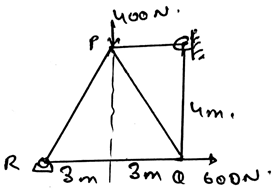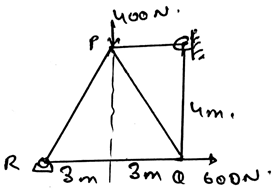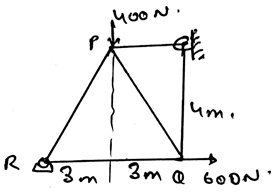This set of Engineering Mechanics Multiple Choice Questions & Answers (MCQs) focuses on “Method of Joints”.
1. If the whole truss is in equilibrium then all the joints which are connected to that truss is in equilibrium. This is known as:
a) Method of joints
b) Section method
c) Scalar field method
d) Vector equilibrium method
View Answer
Explanation: If the whole truss is in equilibrium then all the joints which are connected to that truss is in equilibrium. This is known as method of joints. This is one of the methods to solve for the forces which are acting along the trusses.
2. Find the force in the member vertical at the right, joined by the hinge.
a) 750N
b) 450N
c) 250N
d) 200N
View Answer
Explanation: The direction of the unknown is not known to us. To know the direction of the unknown force we take assumption of it. That is we assume that the particular direction might be the direction of the force and then we do the calculations accordingly. And then we apply the equilibrium equations to the joints.
3. The free body diagram of which part of the section of the truss is made to make use of method of joints?
a) Joints
b) Truss
c) The whole structure
d) The combination of joint and the whole structure
View Answer
Explanation: The free body diagram of joints part of the section of the truss is made to make use of method of joints. Various equations of equilibrium are made to do the calculations. The net force acting on the vertical direction is made zero. Also horizontal direction forces are made to be zero.
4. For applying the method of joint at joints the forces need to coplanar.
a) False
b) True
View Answer
Explanation: The forces are coplanar that’s why they are there in the calculations in the method of joints. The forces are resolved in 2D. This makes the condition of the equilibrium fulfilled and hence the method of joints uses the forces in the same plane for its calculation.
5. For applying the method of joint at joints the forces need to be concurrent.
a) False
b) True
View Answer
Explanation: The forces are concurrent that’s why they are there in the calculations in the method of joints. The forces are resolved in 2D. This makes the condition of the equilibrium fulfilled by cancelling of various force members and hence the method of joints uses the concurrent forces for its calculation.
6. Find the force in the member RQ.
a) 750N
b) 450N
c) 250N
d) 200N
View Answer
Explanation: The direction of the unknown is not known to us. To know the direction of the unknown force we take assumption of it. That is we assume that the particular direction might be the direction of the force and then we do the calculations accordingly. And then we apply the equilibrium equations to the joints.
7. Which of the following conditions are true to make the calculations easy?
First condition: We use the method of a joint to find the forces acting over the joints in the space trusses.
Second condition: In this, we start from the joint having at least one known force and at the most two unknown forces.
a) We only see the first condition and neglect the second condition
b) We neglect the first condition and only see the second condition
c) We neglect both the conditions because calculations are possible without following the first and second conditions
d) First and second conditions are compulsory and can’t be neglected
View Answer
Explanation: This makes the calculations easy. Also for the solving of any equation one requires equal number of variables as that of equal number of an equation. These are the conditions of selecting the joint point involved in the calculations. If still these conditions are not met, calculations can more hectic or impossible.
8. We use the method of joint to find the net force acting over the entire structure.
a) True
b) False
View Answer
Explanation: We use this method for the simplification of the forces in the sections of the structure. Not the entire structure. This means that the statement given is wrong. It should be the joints not the whole structure.
9. The magnitude of the unknown force can’t be known. But the direction can be founded out.
a) The first part of the statement is false and other part is true
b) The first part of the statement is false and other part is false too
c) The first part of the statement is true and other part is false
d) The first part of the statement is true and other part is true too
View Answer
Explanation: The first part is wrong. We can determine the magnitude of the unknown force. It can be done by using the equilibrium equations. That equating the forces zero, of the three different axis. Thus making the components of the unknown founded out.
10. What is after taking the assumption of the direction of the force, the direction comes opposite?
a) The assumption made was wrong and the question can’t be solved further
b) The assumptions are not to be taken
c) The direction is in the opposite sense, and hence the direction is known to us
d) The direction will be already given to us, no need of assuming
View Answer
Explanation: The direction is comes opposite, means that the assumption was wrong. But that doesn’t means that the question can’t be solved further. One needs to change the sign of the direction and the question is solved. Thus the calculations of the force direction.
11. Find the force in the member PQ.
a) 750N
b) 450N
c) 250N
d) 200N
View Answer
Explanation: The direction of the unknown is not known to us. To know the direction of the unknown force we take assumption of it. That is we assume that the particular direction might be the direction of the force and then we do the calculations accordingly. And then we apply the equilibrium equations to the joints.
12. The magnitude of the resultant of the two vectors is always:
a) Greater than one of the vector’s magnitude
b) Smaller than one of the vector’s magnitude
c) Depends on the angle between them
d) Axis we choose to calculate the magnitude
View Answer
Explanation: Yes, the magnitude of the resultant of the two vectors always depends on the angle between them. It might be greater or smaller than one of the vector’s length. For perfectly saying, it does depends upon the angle between them.
13. Find the force in the member PR.

a) 750N
b) 450N
c) 250N
d) 200N
View Answer
Explanation: The direction of the unknown is not known to us. To know the direction of the unknown force we take the assumption of it. That is we assume that the particular direction might be the direction of the force and then we do the calculations accordingly. And then we apply the equilibrium equations to the joints.
Sanfoundry Global Education & Learning Series – Engineering Mechanics.
To practice all areas of Engineering Mechanics, here is complete set of 1000+ Multiple Choice Questions and Answers.
If you find a mistake in question / option / answer, kindly take a screenshot and email to [email protected]


